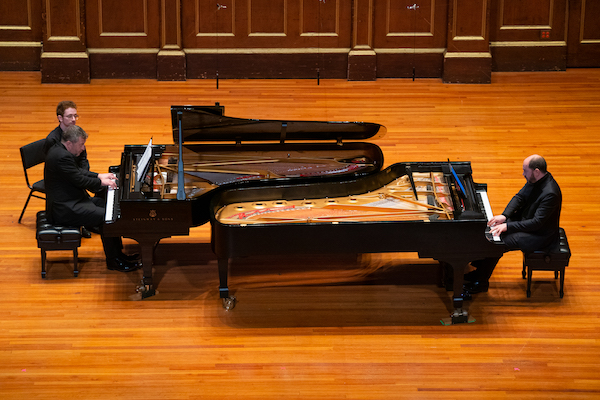Gerstein and Adès ignite a 176-key storm in duo-piano program

Thomas Adès and Kirill Gerstein performed a duo-piano program Friday night at Jordan Hall. Photo: Robert Torres
Last week Kirill Gerstein gave the acclaimed world premiere of Thomas Adès’ Concerto for Piano and Orchestra with the composer conducting the Boston Symphony Orchestra—the culmination of a long professional association, with Gerstein having performed several Adès keyboard works over the years.
The two men have also performed as a piano duo, and did so again Friday night at Jordan Hall with a Celebrity Series concert that showcased the depth of these collaborations.
This program was comprised mostly of works from the early twentieth century by pianist-composers, that reveled in ample technical challenges and big emotions, starting with Debussy’s En blanc et noir.
Debussy composed this work following a period of composer’s block. His depression over World War I and his failing health mingle with a rush of rejuvenated creativity, all of which are manifest in the two fast outer movements. The somber second movement was dedicated to a young man killed in the war.
Unassailable instrumental command, unity of expression and sheer power were on display from the outset. Hammer strokes in the surging first movement always remained melodic. A floating pulse underlined affecting quotations from “A Mighty Fortress Is Our God” and “La Marseillaise” in the central dirge. Yet the lilting Scherzando concluded with Gerstein and Adès conveying a sense of hope.
Shostakovich’s arrangement of Stravinsky’s Symphony of Psalms seemed tailormade for this duo’s synthesis of thunder and contemplation. Set in his neoclassical style, the symphony blends psalm settings with motives from the composer’s Russian Orthodox background. Lucid in construction but unnerving with its modernist harmonies, Shostakovich admired the piece enough to create this two-piano arrangement for his students. It retains the solemn atmosphere and clarity of Stravinsky’s writing on a reduced yet transparent scale.
Gerstein and Adès alternated forceful wallops with the quiet, hypnotic periods in the first movement’s prayer to God. Intuitive balances and immaculate passagework illuminated the score’s relentless motion and tension. The second movement’s fugues were played with a brittle majesty; slight pushes and pauses made for a disturbing confrontation with the Almighty. The final movement’s spiritual ascent threatened to lose cohesion however, with the slow, ponderous tempo more heavy than heavenly.
Witold Lutoslawski’s Variations On A Theme By Paganini offered the most overtly virtuosic work of the evening. The Polish composer supported himself during World War II by playing arrangements of classical music in Warsaw cafes. This work would have spilled some drinks, putting Paganini’s already tortuous variations through the wringer with its keyboard addition of chromaticism, finger-busting polyrhythms, and dense counterpoint.
Gerstein and Adès’ performance was full of huge, precisely executed chords and laser-focused runs. Yet fine details and warm moments still emerged, such as the two pianists finishing each other’s phrases in playful dialogs or the harmonies unfolding during the slow variation.
Debussy also led off the second half, this time with his Lindaraja. This was the composer’s first work for two pianos as well as an early experiment with influences from Spanish music. Debussy’s highly stylized, impressionistic translation of those idiomatic rhythms was rendered with cool phrasing and sensitive interplay.
This subtle reading of Debussy was followed by a muscular transcription, this time Adès’ Concert Paraphrase on Powder Her Face. The 1995 opera centers on the Duchess of Argyll’s scandalous divorce. Adès transcribed four scenes for solo piano in 2009 and expanded them into a piano duo in 2015. Even without lyrics, this arrangement conveys the distinguished, complex and above all tough protagonist, someone the composer thought well-suited to a showpiece “in the manner of Liszt or Busoni.”
Adès’ piano writing is as taxing as it is characterful: crushing chord clusters and cascading arpeggios, disjointed counterpoint filled with offbeat accents and spindly soprano lines, wide sweeps across the keyboard and melodies splintering into fragments. Gerstein and Adès exuded a shared respect and confidence in each other’s playing that seemed to push each other’s technique. The four movements proceed with only brief pauses, making the work sound like one improvised monologue.
Ravel’s La Valse brought the concert to an appropriately thrilling conclusion. This homage to the waltz king Strauss was rejected by Diaghilev for use in a ballet. Ravel never forgave him, but the ballet director had a point: the piece ventures into unexpected directions that would have made dancing difficult, to put it mildly. Yet Gerstein and Adès still made feet tap with their crisp articulation.
The murky opening clouds described by Ravel were downright malevolent in the pianists’ four hands, the ensuing waltz theme entering with understatement and charm. Despite the thick textures, Gerstein and Adès still conjured the light atmosphere of the ballroom. By the end, a well-choreographed storm closed this evening with two masterful musical partners.
Celebrity Series of Boston will present the Hagen Quartet with a program of Schubert, Webern and Beethoven 8 p.m. March 23 at NEC’s Jordan Hall. celebrityseries.org; 617-482-2595.
Posted in Performances




